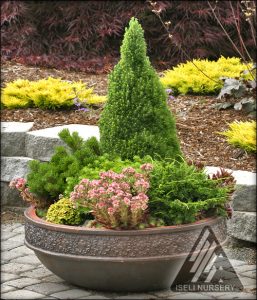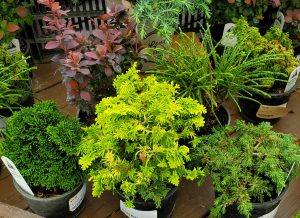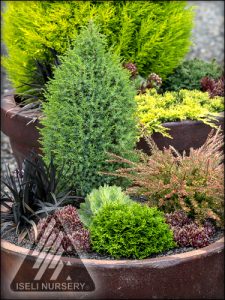 As gardeners become comfortable with container gardening, the palette of eligible plant species keeps expanding. One group to consider are conifers, evergreens of dwarf stature, unusually colored needles or foliage, and unique habits.
As gardeners become comfortable with container gardening, the palette of eligible plant species keeps expanding. One group to consider are conifers, evergreens of dwarf stature, unusually colored needles or foliage, and unique habits.
Varieties of Chamaecyparis, Juniper, Yew, Pine, Spruce, Hemlock, and Fir are commonly planted as bonsai, in mixed containers, or as specimen plants. Compact forms of deciduous shrubs can be grown with this mix, especially if they have attractive foliage, flowers, or fruit (such as barberry, cotoneaster, miniature roses).
Containers may be ceramic pottery, terracotta, or concrete as they offer many choices in size and color. Handcrafted containers of stone and hypertufa are ideal for the diminutive rock garden and miniature landscape.
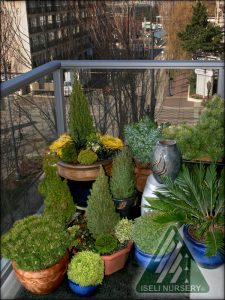 Uses of Conifers in Containers –
Uses of Conifers in Containers –
The portable nature of container gardening allows one to be creative in the arrangement of the pots, changing for special events, holidays, and as the seasons change. Mix tropical plants like ferns and palms into a grouping of evergreens, and add color with pots of annuals, perennials, and forced bulbs.
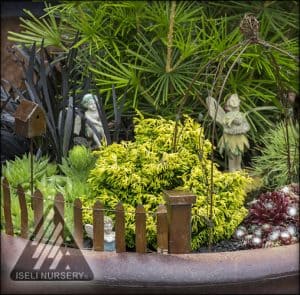
Dwarf conifers are popular in fairy gardens due to their diminutive size and interesting shapes and colors.
The creative opportunities know no end!
Care for Containerized Plants
Winter hardy plants require special consideration for their care once temps drop below freezing. In Missouri, evergreens in containers survive winter best if in a well-lit protected area such as an insulated garage, greenhouse, or other protective structure. Night temperatures can drop close to freezing, but should not get below 25 degrees.
To overwinter containers in temperatures below 25 degrees, insulate the sides and top of the pots with at least 3″ of a breathable material. The plants can be placed inside larger boxes and filled with vermiculite or packing peanuts, wrapped thickly in burlap, or submerged under soil, straw, or leaves.
Contained conifers do best in moist, well-drained soil high in organic matter, generally a high quality potting soil. Use a slow release or water soluble fertilizer during spring and summer (avoid fertilizing in fall and winter, between Labor Day and St Patrick’s Day). Check watering every day, however evergreens don’t like soggy soil. If already moist, don’t water that day. By checking daily, the plant won’t become parched and suffer root damage.
Portions of this article come from Iseli Nursery (www.iselinursery.com).
